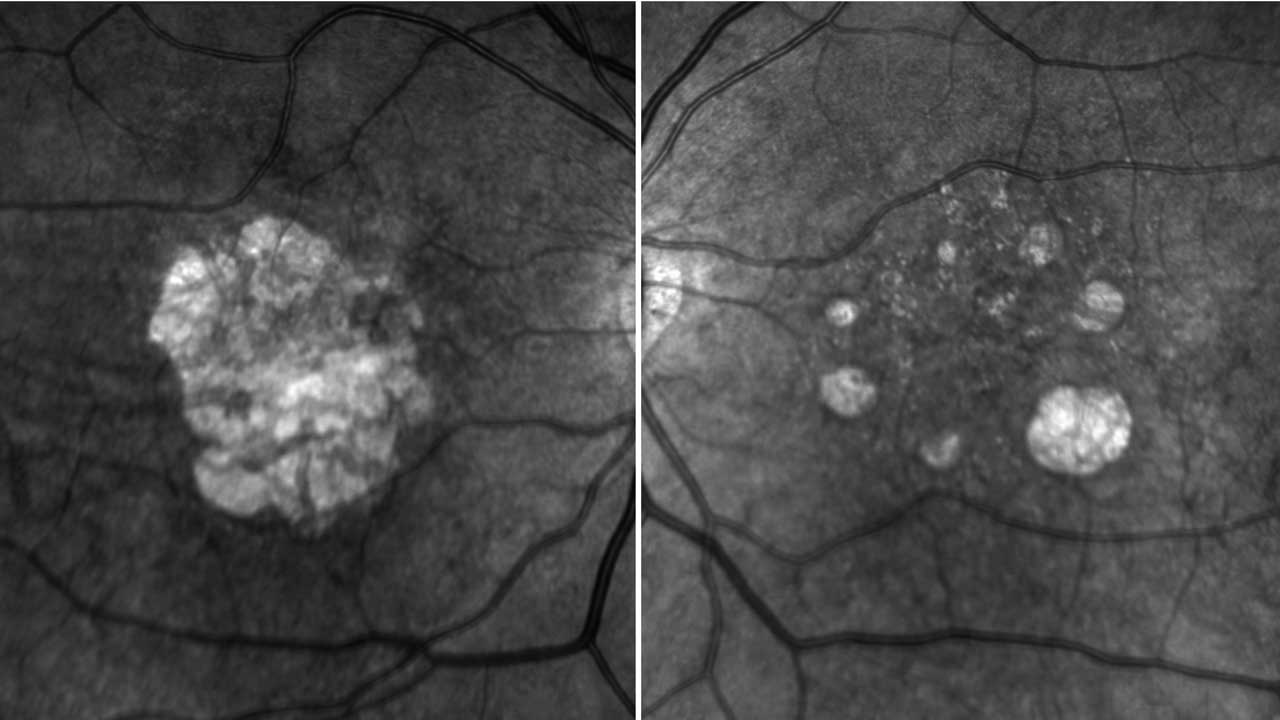In the field of retina, we are fortunate to have multiple treatment options to address disease such as AMD. For neovascular AMD (nAMD), there are multiple intravitreal agents that target vascular endothelial growth factor (VEGF). These have been shown to be effective at improving visual acuity in randomized clinical trials.
However, “real-world” studies illustrate that good long-term outcomes are difficult to achieve.1 Undertreatment can be an issue due to the burden on patients, caregivers and physicians. For example, Syfovre (pegcetacoplan, Apellis Pharmaceuticals) and Izervay (avacincaptad pegol intravitreal solution; Iveric Bio, An Astellas Company) were recently approved for geographic atrophy (GA), but these treatments require frequent clinic visits with intravitreal injections every 1 to 2 months.
Gene therapy may offer therapeutic options to help these concerns. Gene therapy prompts the eye to make a novel therapeutic protein and coax the eye to become a bio factor. AMD gene therapies are applied in a gene agnostic fashion and have the potential to reduce injection burden with a potential “one and done” treatment to a wide population of patients. Gene therapy interventions are also promising for inherited retinal degenerations (IRDs). However, these therapies focus on treating a specific genetic mutation in IRD. This may offer treatment to patients who currently do not have any other options.
The goal of this article is to provide a bird’s eye view of gene therapy treatments in the pipeline for AMD and IRDs.
NEOVASCULAR AMD
RGX-314
RGX-314 (Regenxbio, AbbVie) is an AAV-based gene therapy designed to deliver a gene encoding for an anti-VEGF protein with the goal of sustained protein production by the retinal cells. A Phase 1/2 trial of 42 patients for subretinal RGX-314 showed sustained vision gains at 2 years. At 1.5 years after treatment, patients in some of the higher dose cohorts saw a 58% or 81% reduction in anti-VEGF treatment burden.2 In the Phase 2 AAVIATE study, there was a meaningful reduction in treatment burden at higher doses.3
To deliver RGX-314 underneath the retina, a vitrectomy is performed, and 200 µL is injected into a healthy area of the inferior retina with a 41-g subretinal cannula. The Phase 3 ATMOSPHERE and ASCENT studies with subretinal RGX-314 are currently enrolling.
Suprachoroidal delivery of RGX-314 is also being investigated. Suprachoroidal delivery is an attractive option as it could be given in clinic and may result in less exposure of the inside of the eye to the gene product and may reduce the risk of inflammation. Of note, suprachoroidal RGX-314 is also being investigated for diabetic retinopathy in the Phase 2 ALTITUDE study.4 This study is enrolling patients with moderately severe or severe non-proliferative diabetic retinopathy or mild proliferative diabetic retinopathy.4
Ixo-vec
Ixoperogene soroparvovec is an intravitreal AAV vector carrying an aflibercept coding sequence. Three-year data from the Ixo-vec (Adverum Biotechnologies) Phase 1 OPTIC trial showed sustained aflibercept protein levels in addition to improved retinal thickness on imaging and maintained vision. This was in the setting of a reduction of anti-VEGF injections given over the course of a year.5
The Phase 2 LUNA study also found that 85% and 68% of patients at some dose levels remained injection free at 6 months following treatment.5 This would mean significantly less clinic visits for these patients.
4D-150
4D-150 (4D Molecular Therapeutics) is a dual anti-VEGF transgene that expresses aflibercept and VEGF-C inhibitory RNA and is dosed as a one-time intravitreal injection. The Phase 1/2 PRISM trial has enrolled 51 patients with nAMD who were requiring frequent injections.6
GEOGRAPHIC ATROPHY
JNJ-1887
JNJ-1887 (Janssen) is a one-time intravitreal injection being studied for the treatment of GA. The goal of treatment is to increase the expression of the soluble recombinant version of CD59. CD59 inhibits the membrane attack complex formation, the terminal step of complement-mediated cell lysis, and can help protect retinal cells. A Phase 1 study of 17 GA patients treated with JNJ-1887 showed promising efficacy measures for patients receiving higher doses with a continual decrease in lesion growth over 6-month intervals.7 A Phase 2 PARASOL trial is enrolling.
ASP7317
ASP7317 (Astellas Pharma) is a subretinal therapy derived from human embryonic stem cell-derived retinal pigment epithelial cells to treat GA. A Phase 1b trial is currently enrolling.8
RG6501
RG6501 (OpRegen, Lineage Cell Therapeutics) is a suspension of human retinal pigment epithelium cells delivered subretinally. A Phase 1 study showed improvement of the retinal structure on imaging and a Phase 2 trial will evaluate 60 patients.9

INHERITED RETINAL DEGENERATION
A promising area for gene therapy
Another area for which gene therapy shows significant promise as a treatment strategy is in IRDs. There have been significant advances in the understanding of the genetic bases of IRDs. This field is poised for further leaps that may lead to therapeutic options. Voretigene neparvovec (Luxturna, Spark Therapeutics) became the first FDA-approved gene therapy approved for IRDs caused by variants in the RPE65 gene in 2017.10
A few ongoing clinical trials (listed below) could lead to additional therapies for IRDs over the next several years. Pharmacotherapies that modulate the underlying disease pathophysiology or gene therapies that restore a loss of protein function are being investigated.
Retinitis pigmentosa
Most of the promising gene therapy treatments for IRDs are in retinitis pigmentosa (RP) and focus on rescuing the RPGR gene function. Botaretigene sparoparvovec (MGT009, MeiraGTx/Janssen) is a subretinal gene therapy with AAV vector targeting loss of function mutations in the RPGR gene. It was studied in a Phase 1/2 trial comparing subretinal injection of low, intermediate and high doses in X-linked RP patients. Patients in the two lower dose cohorts demonstrated improved retinal sensitivity and functional vision at 1 year. The Phase 3 LUMEOS trial is underway.7
Laruparetigene zosaparvovec (AGTC-501, Beacon Therapeutics) is an AAV2 capsid delivered subretinally that aims to restore RPGR gene function in patients with X-linked RP. The Phase 1 SKYLINE study included 29 patients and retinal (microperimetry) sensitivity improved at 1 year in all centrally dosed patients. A Phase 2/3 VISTA study is planned for 63 patients.11
Cotoretigene toliparvovec (BIIB112, Biogen) is also a subretinal therapy to rescue RPGR gene function using AAV8 capsids. The Phase 1/2 XIRIUS study did not meet the primary endpoint of improvement in retinal sensitivity, but positive trends seen in low luminance vision measurements have led to a Phase 3 SOLSTICE trial.12
Other conditions
For X-linked retinoschisis, ATSN-201 (Atsena Therapeutics) is a subretinal gene therapy to deliver RS1. It will be examined in a Phase 1/2 trial for patients with mutations in RS1.13
For choroideremia, 4D-110 (4D Molecular Therapeutics) is in a Phase 1/2 study for patients with mutations in the CHM gene. The therapy uses an intravitreal vector and the trial will enroll 13 patients.14
CONCLUSION
Gene therapy is poised to make significant improvements in treatment for a variety of retina conditions, including AMD and IRDs. In the setting of nAMD and GA, potential “one and done” treatments with gene therapy may help to alleviate significant high injection burdens, which are a challenge for patients, caregivers and patients. In the setting of IRDs, such as RP, emerging treatments geared at restoring loss of function proteins, may offer treatment to a subset of patients currently without approved treatment options. OM
REFERENCES
1. Jaffe GJ, Ying GS, Toth CA, et al. Macular Morphology and Visual Acuity in Year Five of the Comparison of Age-related Macular Degeneration Treatments Trials. Ophthalmology. 2019;126(2):252-260.
2. Campochiaro PA, Avery R, Brown DM, Heier JS, Ho AC, Huddleston SM, et al. Gene therapy for neovascular age-related macular degeneration by subretinal delivery of RGX-314: a phase 1/2a dose-escalation study. Lancet. 2024;403(10436):1563-1573.
3. REGENXBIO Announces Positive Interim Data from Phase II AAVIATE Trial of ABBV-RGX-314 for the Treatment of Wet AMD Using Suprachoroidal Delivery. Press release. Jan. 16, 2024. https://ir.regenxbio.com/news-releases/news-release-details/regenxbio-announces-positive-interim-data-phase-ii-aaviater. Accessed May 10, 2024.
4 REGENXBIO. ABBV-RGX-314 for Retinal Diseases. https://www.regenxbio.com/therapeutic-programs/rgx-314/. Accessed May 23. 2024.
5. Adverum Biotechnologies Announces 3-Year Efficacy and Safety Results from the OPTIC Extension Study in Patients with Wet AMD at AAO 2023. Press release. Nov. 4, 2023. https://tinyurl.com/4wrjfakw. Accessed May 15, 2024.
6. 4DMT Presents Positive Interim Data from Randomized Phase 2 PRISM Clinical Trial of Intravitreal 4D-150 Demonstrating Favorable Tolerability & Clinical Activity in Wet AMD. Press release. Feb. 3, 2024. https://ir.4dmoleculartherapeutics.com/news-releases/news-release-details/4dmt-presents-positive-interim-data-randomized-phase-2-prism. Accessed May 10, 2024.
7. Janssen Announces Late-Breaking Data from Two Gene Therapy Programs at the American Academy of Ophthalmology 2022 Annual Meeting. Press release. Oct. 1, 2022. https://tinyurl.com/ywb3nc85. Accessed May 10, 2024.
8. Astellas. A study of the safety and tolerability of ASP7317 in senior adults who are losing their clear, sharp central vision due to geographic atrophy secondary to dry age-related macular degeneration. https://www.clinicaltrials.astellas.com/study/7317-CL-0003/. Accessed May 10, 2024.
9. Hutton D. ARVO 2023: RG6501 (OpRegen) Phase 1/2a clinical results support the potential for cell therapy to curb disease progression in geographic atrophy. Ophthalmology Times. April 26, 2023. https://tinyurl.com/2ja6z5sv. Accessed May 10, 2024.
10. FDA approves novel gene therapy to treat patients with a rare form of inherited vision loss. Press release. Dec. 18, 2017. https://www.fda.gov/news-events/press-announcements/fda-approves-novel-gene-therapy-treat-patients-rare-form-inherited-vision-loss. Accessed May 10, 2024.
11. Beacon Therapeutics Announces Positive 12-Month Data from Phase 2 SKYLINE Trial of AGTC-501 in Patients with X-Linked Retinitis Pigmentosa. Press release. Feb. 8, 2024. https://tinyurl.com/2hj8n34x. Accessed May 10, 2024.
12. Biogen Announces Topline Results From Phase 2/3 Gene Therapy Study for XLRP. Press release. May 14, 2021. https://investors.biogen.com/news-releases/news-release-details/biogen-announces-topline-results-phase-23-gene-therapy-study. Accessed May 10, 2024.
13. Beaney A. First cohort benefits from Atsena Therapeutics XLRS gene therapy. Clinical Trials Arena. May 2, 2024. https://www.clinicaltrialsarena.com/news/first-cohort-benefit-gene-therapy-xlrs/. Accessed May 10, 2024.
14. 4D Molecular Therapeutics Announces First Patient Dosed in Phase 1 Clinical Trial of 4D-110 by Intravitreal Injection for the Treatment of Choroideremia. Press release. July 27, 2020. https://4dmt.gcs-web.com/news-releases/news-release-details/4d-molecular-therapeutics-announces-first-patient-dosed-phase-1. Accessed May 10, 2024.









